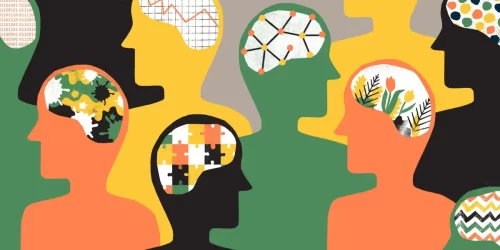
Heart Emoji, Crying Face Emoji: A Reflection on the Emotional Facets of Teaching
In collaboration with Sara Kafashan
This past winter semester, I experienced a familiar feeling: I found myself getting frustrated with students repeatedly emailing me for assistance, but not following the instructions I had provided in multiple different contexts (in class, in video recordings of assignment instructions, in writing, in individual meetings etc.). Some of the emails bordered on rude. I had to steel myself with each email, summoning my cool, calm professorial persona to consistently craft polite yet direct responses.
As the end of semester crept up, students became more anxious and urgent in their tone, concerned about their academic success. I couldn’t help but absorb some of their anxiety. It was hard at times to get distance from these feelings.
In this Hub post, I share some strategies I use to manage my emotional reserves as an educator. These strategies have helped me project emotional control and poise (when I may be feeling anything but on the inside!) and navigate the separation between my professional role and internal experience.
The emotional labour of teaching
Every time I teach a course, I am reminded of the emotional labour I do as an educator to manage the human interactions at the core of teaching and learning. Arlie Hochschild coined the term emotional labour in the late 1970s to describe the performance of emotions considered appropriate in a particular setting. Workplaces have “feeling rules,” Hochschild argued, or norms around how emotions are to be regulated and displayed while carrying out one’s professional responsibilities.
Hochschild’s research focused on the emotional calm projected by flight attendants, but her concept is equally valid – and has been extensively studied – in the realm of education. The educator’s emotional self-control is a core facet of managing the dynamic nature of learning interactions because it sets the tone (calm, reassuring), deescalates tension (through openness and patience), and communicates authority (through confidence).
Responding to students: How I felt . . . and how I responded
As part of my role as faculty, I am aware of the fiduciary responsibility I have to attend to the safety and wellbeing of the students in my classroom. At the same time, I know the limits of my role, especially in the context of post-secondary education, where learners are autonomous adults. I am not a first-aid responder or counsellor to students, but I can be responsive to their learning needs by fielding their questions, monitoring their academic progress, and connecting them as needed to appropriate resources and supports in a timely and caring way.
In the following scenarios, I describe some challenging interactions I have had with students in my almost fifteen years of teaching at post-secondary institutions. In each instance, I identify a) the feelings that these interactions elicited in me, and b) the responses I chose to take.
It’s important to note that having a variety of affective responses to student behaviour is normal. I have experienced a whole rainbow of emotions as an educator from joy and pride to more difficult emotions, including anger, hurt, and sadness. I find that I manage these emotions, especially the difficult ones, by differentiating between my internal experience – which is valid, but not always relevant in responding to the situation – and my professional role as an educator, which has defined boundaries and obligations.
The scenarios
A student discloses in an assignment that they have experienced a sexual assault.
How I felt: Concerned (“Is this student okay?”), distressed (“This is so upsetting to hear”), confused (“What am I supposed to do with this information?”).
How I responded: I was aware that a sensitive and informed approach was needed, and I wanted to take concrete steps to respond to the disclosure. I knew that it was important to believe the student and respond in a compassionate way. I followed the guidelines for a supportive response as outlined in the Sexual and Gender-Based Violence Policy (p. 11), including being non-judgemental and referring the student to the Sexual and Gender-Based Violence Office.
A student writes an email demanding more grades and tells me my grading was “faulty.”
How I felt: Angry (“What!?”), annoyed (“How entitled!”), confused (“Did I grade something incorrectly?”).
How I responded: First, I rechecked the grades to ensure my assessment of the student’s work was accurate. I then responded to the student by email, referring to guidelines I had established with the class early in the semester, communicated in class and in the Instructional Plan. I reiterated the grading standards for our course (e.g., what characterizes a “Pass”) as well as my approach to accepting resubmissions or additional work (e.g., what I accept under what conditions and up to what point in the semester). I was firm but kind in reinforcing these expectations.
A student tells me, “You have ruined my life by failing me in your course.” The student goes on to say they are broke, homesick, and distress.
How I felt: Puzzled (“The course was that important to them?”), angry (“I feel manipulated”), overwhelmed (“I don’t what I’m supposed to do here”), concerned (“This student sounds like they’re in distress”).
How I responded: I responded by email expressing empathy with the student’s distress. I did not address the comment about ruining the student’s life. I was concerned for the student’s overall well-being and indicated this in my email. I referred the student to the CARE team right away, using the CARE Team report form, and let the student know I was making the referral.
Note: If a student persists in emailing or approaching you despite having been provided with support, reach out to Student Rights and Responsibilities for issues related to student conduct. Concerns about a student’s wellbeing necessitate prompt submission of a CARE Team report. For academic concerns, consult the Student Success Services referral page, where faculty can connect students with relevant resources and complete the Faculty Referral Form.
I am grading assignments and realize several students have used generative artificial intelligence (genAI) to write a personal narrative on their behalf.
How I felt: Betrayed (“These assignments are supposed to convey students’ genuine ideas!”), confused (“What were students challenged by in this assignment? Was I not clear enough?”), angry (“Do they think I’m stupid?”), sad (“I wanted to hear students’ ideas . . . this feels so depersonalized”).
How I responded: I followed Conestoga’s Academic Integrity Procedure, first reaching out to the students by email within three business days of noting the issue. Even though I was feeling a lot, I kept my communication to students focused, factual, and process-oriented.
Note: If you could use some language to get you started in writing these emails to students, consult these email templates for the suspected use of genAI and these email templates to support the process of filing an academic offence.
I documented throughout the process, noting down the students I was contacting, a brief description of the suspected use of genAI, and when I had scheduled to meet with students.
Parting thoughts
Because we’re all different, how you might feel in such scenarios may very well look different from how I have described feeling here. That’s okay. In my experience, what’s been most important in navigating my feelings as an educator has been being aware of the procedures, policies, and supports available to guide me, so that I feel prepared and a little less alone.
References
Dewaele, J.-M., Gkonou, C., & King, J. (Eds.). (2020). The emotional rollercoaster of language teaching. Multilingual Matters.
Hochschild, A. R. (2012). The managed heart commercialization of human feeling (Updated, with a new preface.). University of California Press.






